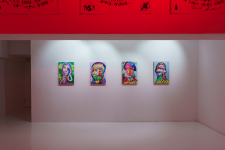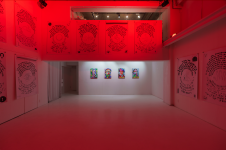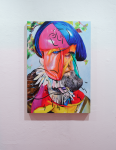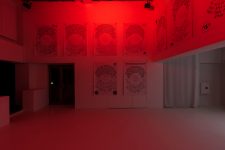PAST EXHIBITION
On Burning Mirrors

- Date
2022.10/5〜10/23
※ Open on Wednesday 〜 Sunday
*Please wear a mask, take your temperature and disinfect yourself when you visit the venue.
*Please note that admission may be restricted depending on the congestion of the venue. Thank you for understanding in advance that you may be required to stand in line.
*Please note that the exhibition period and opening hours may be subject to change depending on the situation. Any changes will be announced on the gallery website and Instagram.
- Open
13:00~19:00
CALM & PUNK GALLERY is pleased to announce the opening of On Burning Mirrors, a solo exhibition by Jonathan Zawada from 9/22 (Thu) to 10/9 (Sun), seven years after his last solo exhibition in Sydney and London in 2015.
Over the past seven years, both before and after the pandemic Zawada has been vigorously active, and involved in a many projects, such as a 3D projection mapping work projected onto the Sydney Opera House, a series of works combining the phenomena of mushroom hybridization and NFTs, work with world-class musicians such as The Avalanches, Flume, Röyksopp, and Mark Pritchard, and participation in Phenomenon: RGB, a major exhibition featuring nine artists from Japan and abroad. After hosting his solo exhibition Touchingly Unfeeling in 2014, CALM & PUNK GALLERY organized and curated Phenomenon: RGB at Laforet Museum in 2019, and invited Zawada to participate in the exhibition along with YOSHIROTTEN, Misa Kono, and others. He also published a book of his work, GASBOOK 31 Jonathan Zawada, at the same time.
“To start making graphics or illustrations, I was not sure whether to buy a computer or an airbrush,” says Zawada, who saved up for a used computer at age 14, and started coding at 16. This is an episode that makes a strange kind of sense given Zawada’s career and his body of work that crosses the boundaries between digital and analog worlds. In fact, many of Zawada’s early works were digitally textured illustrations. These works evolved into a form that combined multifaceted, constructive concepts in the form of paintings, self-made computer games, and installations.
His first solo exhibition, Semantic Webs (derived from the project proposed and promoted by Tim Berners-Lee at W3C in 1998, the idea being to enable computers to autonomously collect, process, and judge information on web pages), was held in 2005. In the 18 years since then, Zawada has consistently made use of “the sensations he has gained through [his] own digital experiences” as the subject matter of his work, while also combining themes of art history and a critique of the IT industry. For example, he has created “still-life images composed entirely of images found through google image search, inspired by my own life, which is spent mostly in front of a screen,” as well as paintings of “graphs based on numerical values of real-world events” and “fingerprint marks left on a touch screen display.” and created “a new work of art that is a reflection of the digital world” (Kasper David Frei). Caspar David Friedrich’s installations that “captures the viewpoints used in Caspar David Friedrich’s paintings and computer games, seen through a superhuman perspective,” and an exhibition that “evokes the view that a pilot sees from the cockpit of a jet plane, based on the sensations he or she receives through a digital device.”
On Burning Mirrors is a new collection of works presented in what is, in some ways, the most analog and old-school manner of Zawada’s career. Paradoxically, however, it is a strong expression of the essence of Zawada’s innovative ideas. How is digital technology – which has become so powerful that it has become part of the natural environment to the people of today – used and how does it affect human morality, kindness, and ideas of beauty? These are some of Zawada’s major themes.
Zawada’s works are aesthetically surprising, yet they also generate a new, critical perspective on contemporary society’s fusion with digital technology. We hope you will enjoy this long-awaited solo exhibition by this extraordinary artist.
artist statement
On Burning Mirrors
There are two parts to the On Burning Mirrors exhibition; a series of typographic statements printed on paper which express concepts for imagined products, economic systems or realities and a series of portrait paintings, the subjects of which have been derived from machine-learning image generation tools.
The title ‘On Burning Mirrors’ comes from a book by Diocles from the 3rd century BC about parabolic mirrors which are mirrors which focus and reflect energy or light around a single point. They can be used to ignite a flame – hence the name of the book – or in modern applications gather a transmission, as in a satellite dish. Since moving out of the city and into the countryside several years ago, all of my internet access has arrived via satellite and it has become an important friend to me.
Works in the show are essentially reflections of individuals and of collective society. They are about how the systems we are within alter and deform us. In particular, they are about how we see ourselves within a world that has decreasing degrees of physical dimension by which we can orient our self-perception. The portraits are aggregate reflections of many, many other portraits, distilled into single faces via machine-learning algorithms. These tools create imagery from textual descriptions within minutes. The portraits presented here derive from variations on the phrase “portrait of a realistic sculpture of a colorful medieval peasant with animal parts”. The tool used is publicly accessible and is trained on a massive data set of imagery and is constantly being refined and improved to the point where it now produces almost flawless imagery that is “as expected”. However, there was a small window of a couple of years during the early evolution of these tools where the results were much wildly erratic and these portraits were created during that blip, before the algorithm had refined what was a ‘preferred’ aesthetic result. It was an interesting moment where the imagery that came back was unexpected, unusual and unpredictable and as such was a unique perspective on what it is to be a person, seen by non-human eyes.
The typographic works are hypothetical products and concepts which distill many unseen aspects of human, social life to reflect it back to an individual. The past 20 years of the internet has reduced each individual to abstracted data points which are allocated into various buckets for the purposes of targeted advertising, but it is rare that we are afforded that perspective on ourselves. I’ve been gathering these ideas over the last two decades as they have occurred to me, often prompted by encountering some new piece of technology like the blockchain or social media and considering what those things might be if they grew up with slightly different base parameters. Initially they came from thinking about how the concept of “big data” only feels manipulative because we, as individuals, don’t have access to both sides of the coin. If, however, we were allowed to see ourselves the way the data sees us, it could be revealing and helpful on a unique, personal level. Fundamentally, they are individual visions of alternate realities that are only slightly different from the one we find ourselves in. Like the AI generated portraits, at a glance they are instantly recognizable and seem like minor tweaks but the subtle irregularities reveal deeply fundamental shifts in the world they reflect.
I think we are less the individuals that we feel we are – or that many types of technology would like us to think we are on their forward facing side – and much more the collective culmination of many inputs that we are when viewed from the back facing side.
Jonathan Zawada
Jonathan Zawada (b.1981, Australia)
Known for his multi-faceted approach to the field of art and design which weave both the analogue and digital, artist Jonathan Zawada is often seeking to create tangible artefacts of transient, ephemeral virtual experiences in his work.
Centered around the intersection and blend between the artificial and the natural, Zawada’s world is hyperreal – delicate and intricately detailed, as well as bold and dynamic.
Zawada’s practice is informed by his early roots in web design and coding and his further evolution into commercial graphic design, illustration and art direction and now includes object and furniture design, sculpture, video, installation, and painting.
He has won awards for his graphic design including two Australian Record Industry Awards (ARIAS) for album artwork and has presented solo exhibitions of his oil paintings and installations in contemporary galleries around the world including Los Angeles, Paris, Tokyo, London, Sydney, and Beijing. Also, he has been appointed as the director for the lighting of the Sails of the Sydney Opera House for the Vivid 2018 where he displayed a 15-minute projection mapped piece entitled Metamathemagical.
Zawada runs the gauntlet of commercial and non-commercial realms; he has a foot firmly in both the commercial and fine art camps, when asked to describe his practice he says, “recently I’ve simply settled on the idea that I like to make things”.
“When I was first introduced to Jonathan’s work the first thing that impressed me was the Diversity of it all and at the same time still a constant voice shining through. I also really enjoy the Rich Vibrancy and boldness, above all though its Jonathan himself and when you look at his work you are seeing various aspects of his personality and outlook on life.”
Mark Pritchard
ten_do_ten
CV
Solo Exhibition
2005:
Semantic Webs at Monster Children Gallery, Sydney, Australia
2008:
Boolean Values at Monster Children Gallery, Sydney, Australia
2011:
Over Time at Prism Gallery, Los Angeles, USA
Free Dumb at Vallery, Barcelona, Spain
2012:
Free Roam Above the Mist at Prism Gallery, Los Angeles, USA
Kindred Spirits at Colette, Paris, France
2013:
Casual Hardcore at Prism Gallery, Los Angeles, USA
PWND at The Popular Workshop gallery in San Francisco, USA
2014:
Real 3D at Sarah Cottier Gallery, Sydney, Australia
Touchingly Unfeeling at Calm & Punk Gallery, Tokyo, Japan
2015:
A Particular Turbulant Wave at BEERS, London, UK
My Sentiments Exactly at Sarah Cottier Gallery, Sydney, Australia
Group and 2-person Exhibitions
2008:
New Moon at Sarah Cottier Gallery, Sydney, Australia
Alphabet at Monster Children Gallery, Sydney, Australia
2009:
Glory Holes at Monster Children Gallery, Sydney, Australia
Batteries Not Included at ACP, Sydney, Australia
Record Time at Palmer Projects, Sydney, Australia
Roku at Monster Children Gallery, Sydney, Australia
2010:
Disorder Disorder at Penrith Regional Gallery, Sydney, Australia
It Was On Earth That I Knew Joy at Scion, Los Angeles, USA
Some Type of Wonderful at China Heights, Sydney, Australia
Semiotics at Nine Lives Gallery, Brisbane, Australia
2011:
O at Sarah Cottier Gallery, Sydney, Australia
Sunset Etc. at Prism Gallery, Los Angeles, USA
Posters of Fortune at Type Directors Club, New York, USA
2012:
Then x Ten, The Power of the Poster, A Herman Miller Exhibition at Fortyfive Downstairs,
Melbourne , Australia
2014:
100% Potential with Ben Barretto at Ben Barretto’s Studio, Los Angeles, USA
2016:
Skin with Flume at Special Group Studios, Sydney, Australia.
Skin with Flume at Space15Twenty, Los Angeles, USA.
Under The Sun with Mark Pritchard at Red Bull Music Studios, New York, USA.
2018:
Chroma at Sarah Cottier Gallery, Sydney, Australia
Open House at Furth & Yashar, Los Angeles, USA
2019:
Phenomenon: RGB at Leforet Museum, Tokyo, Japan
Event
2015:
Goldfish in collaboration with Kim Laughton at the Tomorrow’s Party art and music festival, Beijing, China
2018:
Metamathemagical, a 15-minutes projection mapping piece for Sydney Opera House, at Vivid, Sydney, Australia






